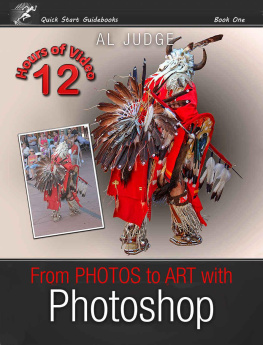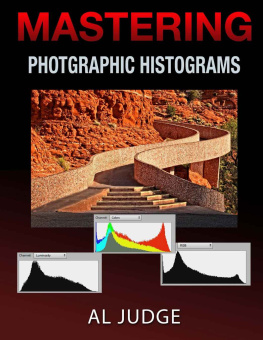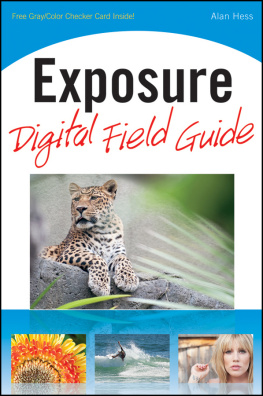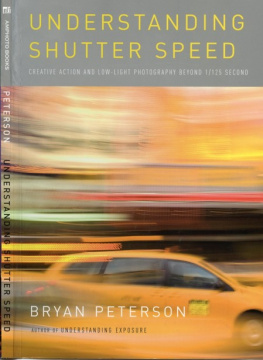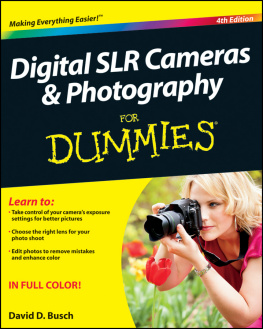Al Judge - Mastering Aperture, Shutter Speed, ISO and Exposure
Here you can read online Al Judge - Mastering Aperture, Shutter Speed, ISO and Exposure full text of the book (entire story) in english for free. Download pdf and epub, get meaning, cover and reviews about this ebook. year: 2014, publisher: Subtle Visions Media, genre: Science fiction. Description of the work, (preface) as well as reviews are available. Best literature library LitArk.com created for fans of good reading and offers a wide selection of genres:
Romance novel
Science fiction
Adventure
Detective
Science
History
Home and family
Prose
Art
Politics
Computer
Non-fiction
Religion
Business
Children
Humor
Choose a favorite category and find really read worthwhile books. Enjoy immersion in the world of imagination, feel the emotions of the characters or learn something new for yourself, make an fascinating discovery.

- Book:Mastering Aperture, Shutter Speed, ISO and Exposure
- Author:
- Publisher:Subtle Visions Media
- Genre:
- Year:2014
- Rating:3 / 5
- Favourites:Add to favourites
- Your mark:
- 60
- 1
- 2
- 3
- 4
- 5
Mastering Aperture, Shutter Speed, ISO and Exposure: summary, description and annotation
We offer to read an annotation, description, summary or preface (depends on what the author of the book "Mastering Aperture, Shutter Speed, ISO and Exposure" wrote himself). If you haven't found the necessary information about the book — write in the comments, we will try to find it.
Al Judge: author's other books
Who wrote Mastering Aperture, Shutter Speed, ISO and Exposure? Find out the surname, the name of the author of the book and a list of all author's works by series.
Mastering Aperture, Shutter Speed, ISO and Exposure — read online for free the complete book (whole text) full work
Below is the text of the book, divided by pages. System saving the place of the last page read, allows you to conveniently read the book "Mastering Aperture, Shutter Speed, ISO and Exposure" online for free, without having to search again every time where you left off. Put a bookmark, and you can go to the page where you finished reading at any time.
Font size:
Interval:
Bookmark:
Mastering Aperture,Shutter Speed, ISO and Exposure:
How They Interact and AffectEach Other
By Al Judge
Sedona, Arizona
Copyright 2012 by AlJudge
Unless otherwisestated, all images and illustrations in this book are copyrighted and theproperty of Al Judge.
Throughoutthis book there are a number of images that have been taken from the WikipediaCommons. These images are in the public domain and free to anyone to use inbooks, magazines, and brochures as long as the source is attributed and theimages arent sold. I will place the note Wikipedia Commons on or under eachof these images.
http://creativecommons.org/licenses/by-sa/3.0/legalcode
The most basicdefinition of Photography is recording how light is reflected from an object orscene. There are also more artistically oriented definitions, such as:
Photographyrecords the gamut of feelings written on the human face, the beauty of theearth and skies that man has inherited, and the wealth and confusion man hascreated. It is a major force in explaining man to man.
Edward Steichen
Regardless of howyou see photography and its purpose, you will still need to understand Exposureand its components Aperture, Shutter Speed, and ISO alsoknown as the Exposure Triangle if you want to have any controlover your results.
The fact that youare reading this book suggests that you have made a commitment to getting themost out of your camera. I commend you for making that decision and will do mybest to save you from the frustration and confusion that most peopleexperience.
Before we doanything else, I thought it might be a good idea to define some terms that areused throughout this book. They will be discussed and defined in more detailas we progress, but I just want to make sure that we have a solid foundationfor clear communication. I have not listed these terms in alphabetical order,but rather in the order of relative importance. Terms that seem to confuse andintimidate most people are at the top of the list.
Aperture A hole or opening through which light travels.
Diaphragm An adjustable mechanism similar to the iris of the human eye that provides away of changing the size of the aperture of a camera.
f-stops Standardized aperture settings. Focal Length (f) / Aperture Diameter.
Depth of Field The amount of the image that is in sharp focus.
ISO (International Standardization Organization ) A measure of light sensitivity in film and in digital camera sensors. Adjusting ISO has no affect uponthe light that enters the camera or that the sensor or film sees. It merelychanges the light sensitivity of the sensor or film.
Exposure The total amount of light that the film or sensor sees.
In-Camera Exposure Meter A device built into the camera that measures lightreflected from the scene being photographed.
Exposure Compensation A way to fine tune the cameras exposure meter.
EV Exposure Value A unit of measurement used by light meters and by the ExposureCompensation function of digital cameras.
Proper Exposure The amount of light necessary to produce a clear and vibrant image.
Histogram A graph composed of 256 vertical bars used to evaluate exposure. Thefarthest left bar represents BLACK, the farthest right bar represents WHITE,and the rest represent shades of grey in Black & White photography or TonalValues in Color Photography. The height of any bar is determined by thepercentage of the overall image that has the same shade of grey or TonalValue. The bars blend in such a way that the appearance is a smooth graph.

Shutter A mechanical device that covers the sensor or film except when they areexposed to light. Some newer digital cameras have electronic Shutters forfaster Shutter Speeds.
Shutter Speed The amount of time that the shutter is held open in order to expose the filmor sensor to light.
Sensor The digital equivalent of film. An electronic device capable of recordingvisual data.
SLR camera A camera with changeable lenses in which the viewfinder image is identical tothe image that the sensor sees. It must also be based on the 35mm film cameramodel. We will talk about this in some detail later in the book with visualaids.
DSLR Adigital SLR camera.
Neutral Grey Card A grey card with 18% reflectance that is used as a color calibration devicefor digital cameras. Also referred to as 18% grey card, white balance card, ormedian grey card.
Lens Surprisingly,this can be a point of confusion since it can refer to a single piece of glassor a camera lens assembly that consists of several pieces of glass, as well asthe aperture, and electronic and mechanical mechanisms. In this book, lenswill mean the lens assembly unless we are talking about optical principles. Inthis case, it is much easier to understand the principles if the lens isimagined as a single piece of glass.

Focal Length f thedistance from the mid-plane of a lens to the point of sharp focus when the lensis focused to infinity. Focal Length is expressed in millimeters (mm).
Field of View or View Angle The angle that is defines the image based on the locationof the camera. It can be measured horizontally, vertically, or diagonally. If measured diagonally, human vision is about 48 degrees. Camera lenses rangefrom a few degrees to about 120 degrees diagonally. The FOV (Field of View) iswhat is seen through the viewfinder at any moment in time.

Wide-Angle Lens A lens that has a view angle that is larger than human vision. The image inthe viewfinder has the appearance of having moved backwards. Up to about 120degrees diagonally.
Telephoto Lens A lens that has a very narrow view angle. It compresses distance and actslike a magnifying glass. Angles can be in the range of 8 degrees diagonally.
Zoom Lens A camera lens that can be zoomed in or out to more precisely frame the image.
Basic Zone Modes Fully automatic camera modes such as Portrait, Landscape, Sports, etc.
Creative Modes Camera modes that give more control to the photographer.
Av Mode Aperture Value Mode or Aperture Preferred Mode. A popular creative mode inwhich you set the f-stop (aperture size) and the camera selects a Shutter Speedbased on the cameras exposure meter reading. Used when Depth of Field is mostimportant.
Tv Mode Time Value Mode or Time Preferred Mode. Another popular creative mode inwhich you select the Shutter Speed and the camera selects the Aperture Value (f-stop)based on the cameras exposure meter reading. Used when freezing the action ormotion blur is desired.
Manual Mode The photographer selects all settings.
Throughout thisbook and any other one dealing with photography, you will often see measurementsexpressed in millimeters terms like 35 mm, 18 mm, 50 mm, 100mm, etc.
Font size:
Interval:
Bookmark:
Similar books «Mastering Aperture, Shutter Speed, ISO and Exposure»
Look at similar books to Mastering Aperture, Shutter Speed, ISO and Exposure. We have selected literature similar in name and meaning in the hope of providing readers with more options to find new, interesting, not yet read works.
Discussion, reviews of the book Mastering Aperture, Shutter Speed, ISO and Exposure and just readers' own opinions. Leave your comments, write what you think about the work, its meaning or the main characters. Specify what exactly you liked and what you didn't like, and why you think so.

